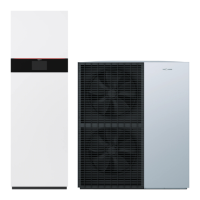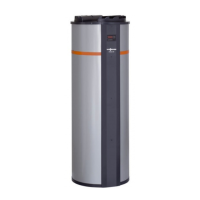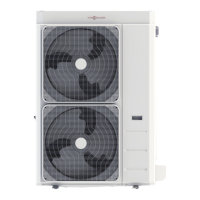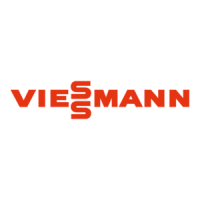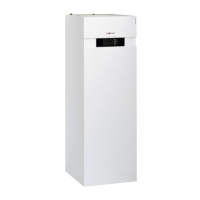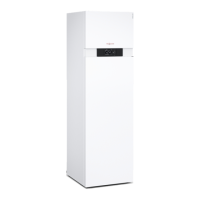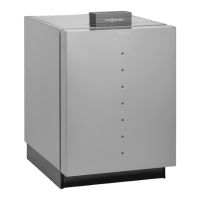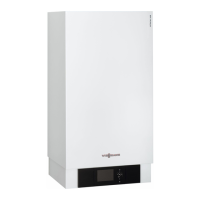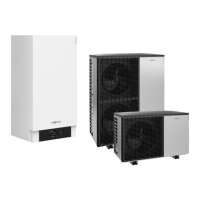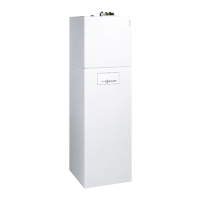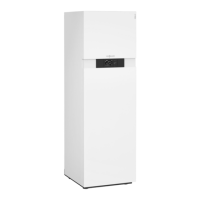Do you have a question about the Viessmann VITOCAL 150-A and is the answer not in the manual?
Follow safety instructions to prevent accidents and material losses.
Outlines hazards of flammable refrigerant and defines safety zones.
Details explosion risks from refrigerant and necessary preventative measures.
Emphasizes authorized contractors for connection and warns about electrical work hazards.
Details dangers of escaping refrigerant and immediate actions, including asphyxiation risk.
Outlines risks of fire, burns, and explosion, and necessary safety actions.
Warns against storing flammable liquids near the indoor unit due to fire risk.
Defines the safety zone around the outdoor unit due to flammable refrigerant.
Details the touchscreen control unit, its integration, and communication capabilities.
Offers advice on reducing energy consumption for room heating and DHW.
Explains how to use the touchscreen for system adjustments and information input.
Explains the buttons and functions available in the menu bar for navigation and selection.
Details how to call up and navigate the main menu for system settings and information.
Explains the "Heating", "Cooling", and "Standby" operating programs for circuits and DHW.
Introduces the procedure for setting time programs for heating, cooling, and DHW.
Explains how to divide the day into time phases for controlling heating/cooling and DHW.
Guides users through setting time phases for room heating/cooling, including start/end times.
Details how to change start/end times and temperature levels for existing time phases.
Explains how to adjust room heating/cooling settings and check system status.
Explains how to set standard, reduced, and comfort room temperatures.
Details how to select operating programs for heating, cooling, or standby modes.
Explains how to set time programs for heating or cooling based on daily time phases.
Guides users on adjusting the heating curve (slope and level) for optimal room heating.
Introduces the "Holiday program" for saving energy during long periods of absence.
Guides users on activating the "Holiday program" to save energy during absence.
Provides instructions for switching off the "Holiday program".
Explains how to set DHW temperature and notes on hygiene requirements.
Guides users on setting time programs for DHW heating and circulation pump operation.
Warns about the risk of scalding with high DHW temperatures and suggests mixing with cold water.
Explains how to enable or disable scald protection to limit DHW temperature to 60°C.
Guides users on switching emergency mode on/off, affecting heating and cooling.
Explains how to check for fault messages and view their details and causes.
Warns that unrectified faults pose life-threatening consequences.
Details methods for shutting down the heat pump with or without frost protection.
Explains the procedure for turning on the heat pump and initial display status.
Provides causes and remedies for rooms being too cold, including heat pump status and settings.
Lists causes and remedies for rooms being too hot, focusing on settings and error messages.
Lists causes and remedies for lack of hot water, including heat pump status and settings.
Explains how to handle "Warning" and "Fault" messages displayed on the system.
Follow safety instructions to prevent accidents and material losses.
Outlines hazards of flammable refrigerant and defines safety zones.
Details explosion risks from refrigerant and necessary preventative measures.
Emphasizes authorized contractors for connection and warns about electrical work hazards.
Details dangers of escaping refrigerant and immediate actions, including asphyxiation risk.
Outlines risks of fire, burns, and explosion, and necessary safety actions.
Warns against storing flammable liquids near the indoor unit due to fire risk.
Defines the safety zone around the outdoor unit due to flammable refrigerant.
Details the touchscreen control unit, its integration, and communication capabilities.
Offers advice on reducing energy consumption for room heating and DHW.
Explains how to use the touchscreen for system adjustments and information input.
Explains the buttons and functions available in the menu bar for navigation and selection.
Details how to call up and navigate the main menu for system settings and information.
Explains the "Heating", "Cooling", and "Standby" operating programs for circuits and DHW.
Introduces the procedure for setting time programs for heating, cooling, and DHW.
Explains how to divide the day into time phases for controlling heating/cooling and DHW.
Guides users through setting time phases for room heating/cooling, including start/end times.
Details how to change start/end times and temperature levels for existing time phases.
Explains how to adjust room heating/cooling settings and check system status.
Explains how to set standard, reduced, and comfort room temperatures.
Details how to select operating programs for heating, cooling, or standby modes.
Explains how to set time programs for heating or cooling based on daily time phases.
Guides users on adjusting the heating curve (slope and level) for optimal room heating.
Introduces the "Holiday program" for saving energy during long periods of absence.
Guides users on activating the "Holiday program" to save energy during absence.
Provides instructions for switching off the "Holiday program".
Explains how to set DHW temperature and notes on hygiene requirements.
Guides users on setting time programs for DHW heating and circulation pump operation.
Warns about the risk of scalding with high DHW temperatures and suggests mixing with cold water.
Explains how to enable or disable scald protection to limit DHW temperature to 60°C.
Guides users on switching emergency mode on/off, affecting heating and cooling.
Explains how to check for fault messages and view their details and causes.
Warns that unrectified faults pose life-threatening consequences.
Details methods for shutting down the heat pump with or without frost protection.
Explains the procedure for turning on the heat pump and initial display status.
Provides causes and remedies for rooms being too cold, including heat pump status and settings.
Lists causes and remedies for rooms being too hot, focusing on settings and error messages.
Lists causes and remedies for lack of hot water, including heat pump status and settings.
Explains how to handle "Warning" and "Fault" messages displayed on the system.
| Refrigerant | R32 |
|---|---|
| Type | Air Source Heat Pump |
| Application | Heating and Cooling |
| Energy Efficiency Class | A+++ |
| Sound Power Level (Outdoor Unit) | 49 - 62 dB(A) (depending on model) |
| Operating Temperature Range (Heating) | -20°C to +35°C |
| Operating Temperature Range (Cooling) | +10°C to +46°C |
| Dimensions (Outdoor Unit) | 950 x 370 x 950 mm |
| Weight (Outdoor Unit) | 120 - 180 kg |
